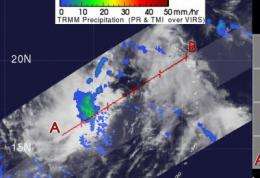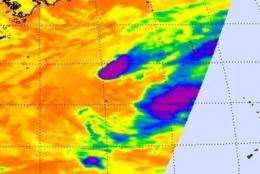System 97W's 'castle wall' breached, and opened up to dissipation

The "walls" of System 97W have been breached, and residents in the Western Pacific Ocean no longer have a tropical cyclone to worry about today. The Joint Typhoon Warning Center cancelled their "formation alert" for System 97W. System 97W is following in Nida's footsteps and is headed for dissipation. Nida has now officially dissipated.
Animated infrared satellite imagery from early today, December 4, showed that the same thing that happened with Nida has happened with System 97W: its low-level circulation center is now exposed. That means that outside influences like wind shear and dry air can work their way into System 97W's center and weaken it from the inside out.
Think of a tropical cyclone's center of circulation like a castle wall. Once it is breached, anything from the outside can enter and take over or destroy whatever is inside.
System 97W's open center is near 17.3 North latitude and 141.0 East longitude, about 310 nautical miles northwest of Guam. Satellite data shows that the deepest convection (strongest thunderstorm activity) is to the north and northwest of the center, pushed there from wind shear.
The Tropical Rainfall Measuring Mission (TRMM) Satellite, managed by NASA and the Japanese Space Agency flew over System 97W at 15:35 UTC yesterday (10:35 a.m. ET). At that time TRMM's data noticed that the low-level center of circulation was already becoming elongated (an indication that wind shear is stretching the storm, and skewing circulation), and the heavier rains were located from 60 to 120 nautical miles northwest of the storm's center.

The Atmospheric Infrared Sounder (AIRS) instrument on NASA's Aqua satellite captured an infrared image of 97W on Dec. 3 at 1653 UTC that showed System 97W was already elongated.
Not only is System 97W getting weakened from an open "wall" but it's also moving into an area where the wind shear is higher. The vertical wind shear speeds are between 25 and 35 knots (28-40 mph) from the south. Not only that, but there's a cold front approaching, too.
System 97W is expected to track to the north and fizzle as it encounters that cold front and high wind shear.





















